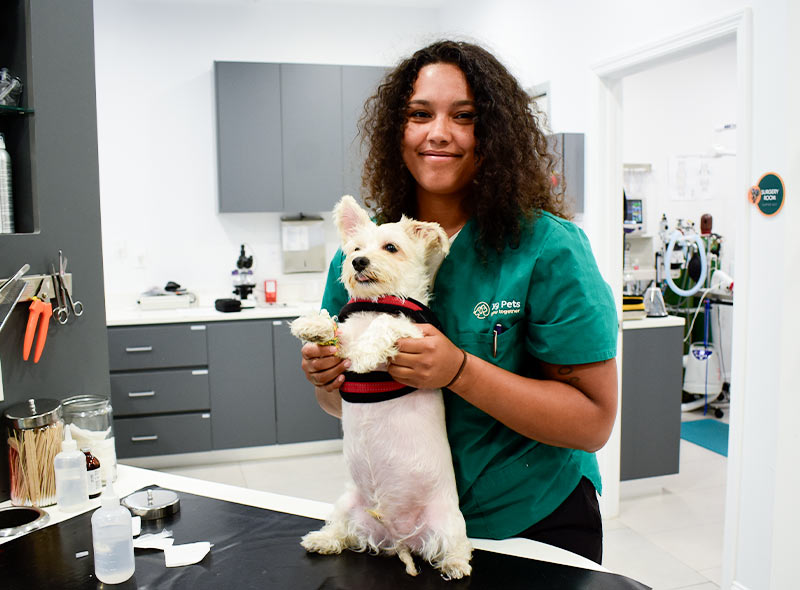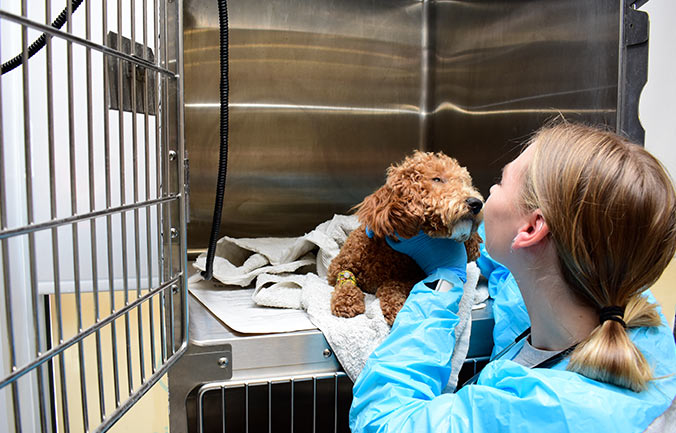
My Pet Has Diarrhea
Diarrhea is a common condition in pets that can be caused by a variety of factors, including infections, dietary indiscretion, parasites, or underlying health issues. While occasional diarrhea may not be a cause for alarm, persistent or severe diarrhea warrants a thorough investigation by the veterinary team at Ivy Pets
Exams and Diagnostic Care Available at
If Your Pet Has Diarrhea:
It is important to monitor your pet carefully. You should call us if:
- Your pet’s diarrhea lasts more than 24-48 hours: Persistent diarrhea can lead to dehydration and indicate an underlying issue.
- Presence of blood or mucus: Blood or mucus in the stool can be a sign of infection, parasites, or other serious conditions.
- Your pet is lethargic or has a fever: If your pet seems unusually tired or has a fever, these symptoms could indicate a more serious illness.
- Vomiting along with diarrhea: This combination can quickly lead to dehydration and may point to gastrointestinal problems or poisoning.
- Your pet is not drinking water: Dehydration is a major concern with diarrhea, so if your pet refuses water, seek veterinary care immediately.
- Weight loss or significant appetite changes: These can be signs of a chronic condition that needs medical evaluation.
- Your pet is very young, old, or has other health conditions: Pets with weakened immune systems or underlying conditions are at greater risk of complications.
- Diarrhea has a foul smell or unusual color: Very dark, tarry, or pale stools could indicate internal bleeding or liver issues.
Diagnostic Tools for Diagnosing Why Your Pet Has Diarrhea
Physical Examination and Medical History
The first step in diagnosing diarrhea in dogs involves a detailed physical examination. Our veterinarian will ask about the dog’s medical history, diet, recent activities, and any other symptoms like vomiting, lethargy, or weight loss. A physical exam helps to assess the dog’s overall health, checking for signs of dehydration, abdominal pain, or other abnormalities.
Fecal Examination
One of the most common and essential diagnostic tests for diarrhea is the fecal examination. This test helps identify parasites, bacteria, and other pathogens that may be causing diarrhea.
- Fecal Flotation: This test detects the presence of internal parasites such as roundworms, hookworms, and whipworms by mixing a fecal sample with a solution that causes parasite eggs to float.
- Fecal Smear: A direct smear of the feces may reveal bacterial overgrowth, protozoa, or inflammatory cells.
- Fecal Culture: This test is used to identify specific types of bacteria that may be causing the diarrhea, such as Salmonella or Campylobacter.
Blood Tests
Blood tests, including a complete blood count (CBC) and blood chemistry panel, are often performed to evaluate the dog’s overall health. These tests can provide clues about systemic infections, inflammation, dehydration, anemia, or liver and kidney function. In cases of chronic or severe diarrhea, blood tests are essential to assess how the body is responding to the illness and whether any organ systems are being affected.
- Complete Blood Count (CBC): This test examines the white blood cell count (to assess for infection or inflammation), red blood cell count (to detect anemia), and platelet count (to check clotting ability).
- Blood Chemistry Panel: It measures the levels of various enzymes, electrolytes, and proteins to evaluate the function of the liver, kidneys, and pancreas.
X-Rays (Radiographs)
Abdominal X-rays are often used to look for abnormalities in the gastrointestinal tract, such as blockages, tumors, or foreign objects. This imaging technique can also reveal if the intestines are distended with gas, indicating a possible obstruction. While X-rays do not always provide detailed information about the soft tissues, they can rule out serious causes of diarrhea that require immediate intervention.
Ultrasound
Abdominal ultrasound is a more advanced imaging technique that provides a detailed view of the internal organs. Ultrasound can help detect changes in the intestines, pancreas, liver, or other abdominal organs that may be contributing to the diarrhea. It’s particularly useful for identifying masses, thickening of the intestinal walls, or other abnormalities that might not be visible on an X-ray.
Endoscopy
In some cases, an endoscopy may be required to directly visualize the inside of the dog’s digestive tract. During this procedure, a small, flexible tube with a camera is inserted into the dog’s stomach and intestines, allowing the veterinarian to look for signs of inflammation, ulcers, or other abnormalities. Biopsies (small tissue samples) can also be taken during an endoscopy for further analysis. This test is especially useful for diagnosing chronic diarrhea or conditions like inflammatory bowel disease (IBD).
Biopsies
If a more invasive approach is needed, surgical biopsies of the intestines or other organs may be performed. Biopsy samples are sent to a lab for histopathology, where they are examined for inflammation, cancer, or other cellular abnormalities. This procedure is typically reserved for cases where other diagnostic tools have failed to provide a conclusive diagnosis, or when there is suspicion of serious diseases like intestinal cancer.
We Can Help If Your Pet Has Diarrhea
Diagnosing the cause of diarrhea in pets requires a combination of careful clinical examination and appropriate diagnostic tests. Depending on the severity and duration of the diarrhea, veterinarians may use a range of tools such as fecal exams, blood tests, imaging techniques, and specialized laboratory tests to determine the underlying cause. Once a diagnosis is made, a targeted treatment plan can be developed to help the dog recover quickly and prevent future episodes of diarrhea.

Ready to subscribe to our news letter?



